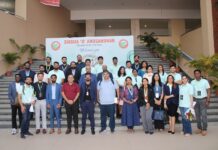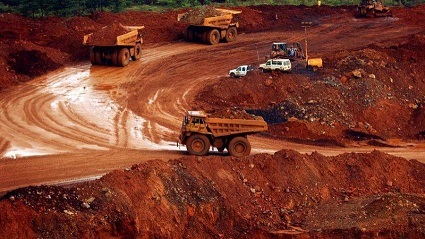By Our Correspondent
NEW DELHI/BHUBANESWAR: Mining, being the source of raw materials for Indian industries and society, is crucialfor both Atmanirbhar Bharat as well as for becoming a $ 5 trillion economy by 2024. Forachieving this vision, the Indian mining sector has to become globally competitive and thecountry needs to shift its focus towards exploration and development of minerals which weimport heavily. Attracting FDI and modern technology are therefore crucial for unlocking India’s full mineral potential and accelerating employment generation, particularly in the remote and tribal regions.
Having been a part of the ancient Gondwana supercontinent, India, South Africa and Australia share similar geological and mineral potential even today. Yet, despite such mineral potential, India is under-explored and has failed to attract mineral investment unlike its geological siblings. The country has not only missed out on FDI, but also associated modern technologies for exploration which has constrained us to only produce easy-to-find bulk minerals, which are often surficial in nature.
India’s obsession with surficial minerals explains why the contribution of mineral sector (excluding petroleum and natural gas) in India’s GDP is so low and stood at 1.75% in 2018-. Presently, 70% of the mineral production in value terms comes from coal & lignite (48%), iron-ore (19%) and limestone (3%), which are widely available surficially in the country and are much easier to explore; whereas India imports minerals like cobalt, platinum, nickel, copper, gold, diamond, rare-earths, etc. which are difficult-to-find and high-value minerals.
Consequently, India has become a net mineral importer.The total value of the production of major and minor minerals for 2018-19 works out to be Rs. 2,44,216 crores, whereas India imported minerals, metals and their products worth Rs. 6,20,406 crores in 2019-20. It is therefore necessary that the nation become self-sufficient in minerals which we import. Achieving this requires attracting FDI and technology in mining so as to enable entrepreneurs to generate adequate ROI commensurate to the exploration risk, and timely development of high-value mineral discoveries. Three key ingredients are necessary to attract latest technology and investment in mining (a) geological prospectivity, (b) political stability, and (c) attractive fiscal regime.
Geological prospectivity indicates the mineral potential of a country which can create value for all stakeholders – investors, Government, community and society at large. Unfortunately, out of the total obvious geological potential (OGP) area of 0.571 million square kilometre, only 10% of the OGP area has been explored and out of this, mining is carried out in meagre 1.5% of the OGP area. Although India has a stable political regime, its mining legislation has been unstable.Instability in India’s mineral legislation has sent a wrong signal to domestic and international investors and therefore India no longer finds a place among attractive mining destinations in Fraser Institute’s Annual Survey for the last three years.
Despite the Government’s reduction in corporate tax rate, mining industry in India is still the highest taxed in the world, with Effective Tax Rate of 54% – 58%. In addition to this, there are numerous taxes / payments to Government, which impact the cost as well as viability of mining in India. The high taxation on mining in India alongwith inordinate delays in grant and development of mines have already led to several major international players exiting the country. The MMDR Amendment Act, 2015 changed the very nature of mining regime in the country, with auction becoming the sole method of grant of mining concessions. Auction system has completely failed for resource development. Out of 102 mineral blocks auctioned so far, 90% of the blocks are for surficial minerals and only 10% are for deep-seated minerals. Despite lapse of more than 5 years, not even a single mining lease has been executed / operationalised in case of the 52 greenfield auctioned blocks; whereas prior to auction regime, 2754 mining leases were executed during 2006-10 and 494 mining leases were executed during 2010-14, most of which were greenfield. Exploration under the auction regime has also suffered a similar fate, with no takers for Non-Exclusive Reconnaissance Permit so far.
Upon analysis of the 97 blocks auctioned as of June, 2020, it is observed that 102.93% of the estimated value of resources will go to the Government as revenue while nothing will remain with the mining companies. Since mining companies will also have to incur operational cost, pay corporate tax and various other taxes/cess etc., the unsustainable high bids mean loss / negative return on investment for the mining entities.
Auction regime has thus put the whole process of mineral development into the realm of astrology which cannot be predicted in the minerals and metals trade where booms and depressions alternate. While before auctions, there was high opportunity to create new jobs through granting the mining leases, but since the auction regime started in India w.e.f. 12th January 2015, the mining sector has been crippled – no exploration and no green field mines and – hence no new employment opportunities in mining. Mining in India is a labour intensive activity and creates employment opportunities in the hinterland. Mining sector creates 13 times more jobs than in agriculture and 6 times more than in manufacturing. In addition, for every single job created in the mining sector, another 10 jobs (indirect jobs) are generated along the supply chain.
It is essential for the country to concentrate on exploration and production of minerals / metals which we import, which are also of strategic nature and essential for national security and defence technology. Mineral exploration is the lifeline of mining, but is a high-risk high-reward activity with
a success rate of 1:100. Therefore, mineral rich countries such as US, Canada, Australia, Brazil, South Africa, Chile, Mexico etc. do not spend tax payers’ money on the risky venture like exploration. Rather, these resource-rich countries have adopted the system of FirstCome-First Served (FCFS) for their resource development, which is transparent and nondiscretionary when implemented in true spirit. These countries entrust mineral exploration to private companies, popularly known as junior exploration companies which possess the necessary domain expertise and usually raise funds from venture capital or hedge funds. For developing its mineral resources, India should stop experimenting with tax payers’ money and adopt the international best practice of FCFS, alongwith freedom to sell / transfer the concessions, security of tenure and seamless transition to a mining company, all of which are key to success of FCFS system. These favourable conditions will attract FDI and junior explorers into India who will bring with them the necessary technology and domain expertise for unravelling India’s mineral potential.
For junior exploration companies to come, explore and invest, it is essential that mining is recognised as an independent activity and not made captive to an industry. The system of acquiring captive mines has led to selective mining limited to the requirements of the plant, wastage of resources and minimal exploration, etc. and therefore needs to be done away with. At present, the process of grant of statutory clearances such as like Environmental Clearance (EC), Forest Clearance (FC), Wildlife clearance, land acquisition etc. for mining projects is quite cumbersome, uncertain and takes minimum 3–5 years. Hence, timely grant of approvals by Government is a must for attracting investment and improving ease of doing mining in India. There should be single appraisal system for EC, FC and Wildlife clearances, as all three inherently evaluate the impact of a project on flora, fauna and ecosystem.
Unlike Atomic Energy, Science & Technology, Earth Science Ministries / Departments, which are headed by specialists, Ministry of Mines and State Departments of Mines and Geology are now-a-days led mostly by people who do not have domain expertise. For sustainable development and exploration of minerals, the persons in mining department / ministries at all-India and states level have to keep track with new and state-of-the-art technologies evolved in the resource rich countries, nature, origin and occurrence of minerals, their distribution world over, rate of their depletion, advances in extraction and process technologies etc., apart from policy issues. Therefore, the Government of India should consider to constitute a separate alI-India service of Geologists and Mining Engineers so that specialised domain experience is available to take a long-term view for the growth and thrust areas for exploration and mine development.
If India has to explore its mineral deposits for which the country is dependent on imports and which are generally deep-seated, we have to revise our exploration policy in line with global practice. Let us therefore reform and streamline the regulatory regime to be in line with modern and positive outlook. It is hoped that the all-India service for Geologists and Mining Engineers being proposed may overcome the present lacunae and attract FDI, technology and talent in the mining and metals sector. It will also help reduce our dependence on mineral imports and result in a globally competitive mining sector, thus moving towards an ‘Atmanirbhar Bharat’.






















